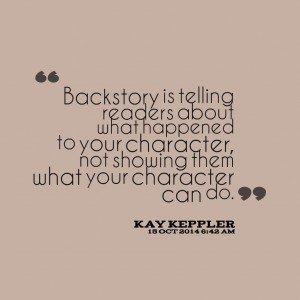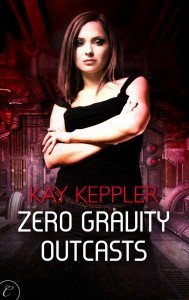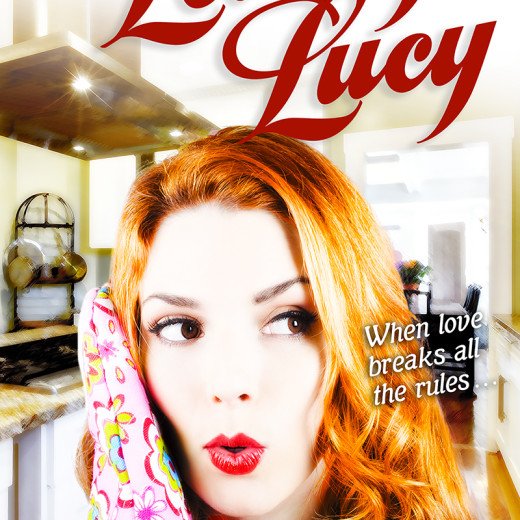Backstory: Leave It In The Past By Kay Keppler
 Join me in giving a warm welcome back to our monthly columnist, author Kay Keppler, as she shares “Backstory: Leave It In The Past.” Enjoy!
Join me in giving a warm welcome back to our monthly columnist, author Kay Keppler, as she shares “Backstory: Leave It In The Past.” Enjoy!
***
You have a great story with wonderful characters who overcame grievous wounds—abused childhoods, broken marriages, or alcoholic parents. How do you handle the task of explaining these life-defining experiences? In prologue, dialogue, monologue, exposition, flashback?
Here’s what you do about backstory: leave it out.
As the author, you need to know everything about your characters—and I mean everything. Their parents, siblings, children, pets, favorite foods, and history, including grievous wounds—these are all part of what enrich your characters and make them come alive for your readers. That is, come alive in the present. Not in the past.
Backstory is for you to know, not for you to bore your readers with. Readers turn the pages of your book because they want to discover the arc or journey that your character begins today—not the journey they took and that changed them ten, twenty, or thirty years ago.
Of course your characters’ life-defining moments helped shape their outlook. But those moments were in the past—sometimes far in the past. Your characters were changed then by those events. They built on those experiences and now they are someone else—someone in the present, in the story you are writing now.
 “But backstory is about motivation,” many will say. No, it isn’t. Say your antagonist had a terrible childhood and was enraged by authority, and you want to use that as a reason why he became a cop killer. That history doesn’t work as motivation because lots of people had terrible childhoods and were enraged by authority and didn’t become cop killers. A historical motivation is too facile. You need specific and immediate motivation. Cop killers become cop killers because something (say, an unwarranted traffic stop or a judge pounding a gavel on a decision) triggers a murderous rage in the now.
“But backstory is about motivation,” many will say. No, it isn’t. Say your antagonist had a terrible childhood and was enraged by authority, and you want to use that as a reason why he became a cop killer. That history doesn’t work as motivation because lots of people had terrible childhoods and were enraged by authority and didn’t become cop killers. A historical motivation is too facile. You need specific and immediate motivation. Cop killers become cop killers because something (say, an unwarranted traffic stop or a judge pounding a gavel on a decision) triggers a murderous rage in the now.
It’s fine if Something Bad happened to your character ten years ago and she changed because of it—but then Something Bad happened today. Partly because her memories and experiences made your protagonist who she is, but mostly because the Bad Thing that happened today really cheesed her off, she took action—she set the plot in motion. That’s the story you want to write. As Jennifer Crusie says, it’s not that our pasts don’t shape who we are today, it’s that our pasts don’t change who we are today, and change is what story is about—story begins with the day that’s different.
Your character isn’t who she was in the past—it’s who she is now: how she thinks, talks, acts, and resolves problems today. Backstory is telling readers about what happened to your character, not showing them what your character can do.
However—if the moment in the past is truly the one life-defining moment for your character, then that’s the story you probably should be writing. But in real life—and in fiction—most people have multiple defining moments. If the story you’re writing is in the now, with the life-defining journey, arc, and change happening in the present, then forget about the backstory. You don’t need it. And your readers will never miss it.
Jennifer Crusie has a terrific blog where she talks about writing, popular culture,and anything else that interests her. You can read it at http://www.arghink.com.
***
ABOUT THE AUTHOR
 KayKeppler (www.kaykeppler.com) is an author Zero Gravity Outcasts, Betting on Hope, Gargoyle: Three Enchanting Romance Novellas, and editor of fiction and nonfiction –Angel’s Kiss and Outsource It! She lives in northern California. Contact her here at Writer’s Fun Zone in the comments below, or at kaykeppler@yahoo.com to ask questions, suggest topics, or if you prefer, complain.
KayKeppler (www.kaykeppler.com) is an author Zero Gravity Outcasts, Betting on Hope, Gargoyle: Three Enchanting Romance Novellas, and editor of fiction and nonfiction –Angel’s Kiss and Outsource It! She lives in northern California. Contact her here at Writer’s Fun Zone in the comments below, or at kaykeppler@yahoo.com to ask questions, suggest topics, or if you prefer, complain.






